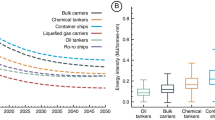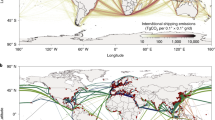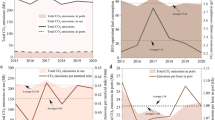Abstract
The decarbonization of shipping has become an important policy goal. While integrated assessment models (IAMs) are often used to explore climate mitigation strategies, they typically provide little information on international shipping, which accounts for emissions of around 0.7 GtCO2 yr−1. Here we perform a multi-IAM analysis of international shipping and show the potential for decreasing annual emissions in the next decades, with reductions of up to 86% by 2050. This is primarily achieved through the deployment of low-carbon fuels. Models that represent several potential low-carbon alternatives tend to show a deeper decarbonization of international shipping, with drop-in biofuels, renewable alcohols and green ammonia standing out as the main substitutes for conventional maritime fuels. While our results align with the 2018 emission reduction goal of the International Maritime Organization, their compatibility with the agency’s revised target is still subject to a more definitive interpretation.
This is a preview of subscription content, access via your institution
Access options
Access Nature and 54 other Nature Portfolio journals
Get Nature+, our best-value online-access subscription
$29.99 / 30 days
cancel any time
Subscribe to this journal
Receive 12 print issues and online access
$209.00 per year
only $17.42 per issue
Buy this article
- Purchase on Springer Link
- Instant access to full article PDF
Prices may be subject to local taxes which are calculated during checkout





Similar content being viewed by others
Data availability
The underlying data are available via Zenodo at https://doi.org/10.5281/zenodo.10815601 (ref. 70). Source data are provided with this paper.
Code availability
The models are documented on the common IAM documentation website (https://www.iamcdocumentation.eu/index.php/IAMC_wiki). Some of them have published open-source code (for example, WITCH, https://github.com/witch-team/witchmodel). For a brief documentation of the models and main concepts, see Supplementary Sections 2 and 3.
References
Faber, J. et al. Fourth IMO GHG Report (International Maritime Organization, 2021).
International shipping. International Energy Agency https://www.iea.org/reports/international-shipping (2023).
EEXI and CII—ship carbon intensity and rating system. International Maritime Organization https://www.imo.org/en/MediaCentre/HotTopics/Pages/EEXI-CII-FAQ.aspx (2019).
EEXI—Energy Efficiency Existing Ship Index (DNV GL, 2021).
Comer, B. & Carvalho, F. IMO’s Newly Revised GHG Strategy: What It Means for Shipping and the Paris Agreement (ICCT, 2023).
Carvalho, F. et al. Prospects for carbon-neutral maritime fuels production in Brazil. J. Clean. Prod. 326, 129385 (2021).
Vermeire, M. B. Everything You Need to Know about Marine Fuels (Chevron Marine Products, 2021).
World bunker prices. Ship & Bunker https://shipandbunker.com/prices (2022).
Maritime Forecast to 2050 (DNV, 2021).
Englert, D. & Losos, A. Charting a Course for Decarbonizing Maritime Transport: Summary for Policymakers and Industry (World Bank, 2021).
A Pathway to Decarbonise the Shipping Sector by 2050 (IRENA, 2021).
Müller-Casseres, E., Edelenbosch, O. Y., Szklo, A., Schaeffer, R. & van Vuuren, D. P. Global futures of trade impacting the challenge to decarbonize the international shipping sector. Energy 237, 121547 (2021).
Moss, R. H. et al. The next generation of scenarios for climate change research and assessment. Nature 463, 747–756 (2010).
van Vuuren, D. P. et al. The representative concentration pathways: an overview. Clim. Change 109, 5–31 (2011).
Clarke, L. et al. in Climate Change 2014: Mitigation of Climate Change (eds Edenhofer, O. et al.) Ch. 6 (IPCC, Cambridge Univ. Press, 2014).
van Vuuren, D. P. et al. Energy, land-use and greenhouse gas emissions trajectories under a green growth paradigm. Glob. Environ. Change 42, 237–250 (2017).
Gambhir, A. et al. Assessing the feasibility of global long-term mitigation scenarios. Energies https://doi.org/10.3390/en10010089 (2017).
Fujimori, S. et al. SSP3: AIM implementation of Shared Socioeconomic Pathways. Glob. Environ. Change 42, 268–283 (2017).
Kriegler, E. et al. Fossil-fueled development (SSP5): an energy and resource intensive scenario for the 21st century. Glob. Environ. Change 42, 297–315 (2017).
Grubler, A. et al. A low energy demand scenario for meeting the 1.5 °C target and sustainable development goals without negative emission technologies. Nat. Energy 3, 515–527 (2018).
Rogelj, J. et al. Scenarios towards limiting global mean temperature increase below 1.5 °C. Nat. Clim. Change 8, 325–332 (2018).
Riahi, K. et al. Cost and attainability of meeting stringent climate targets without overshoot. Nat. Clim. Change 11, 1063–1069 (2021).
van Soest, H. L. et al. Global roll-out of comprehensive policy measures may aid in bridging emissions gap. Nat. Commun. 12, 6419 (2021).
Riahi, K. et al. in Climate Change 2022: Mitigation of Climate Change (eds Shukla, P. R. et al.) Ch. 3 (IPCC, Cambridge Univ. Press, 2022).
van Beek, L., Hajer, M., Pelzer, P., van Vuuren, D. & Cassen, C. Anticipating futures through models: the rise of Integrated Assessment Modelling in the climate science–policy interface since 1970. Glob. Environ. Change 65, 102191 (2020).
Guivarch, C. et al. in Climate Change 2022: Mitigation of Climate Change (eds Shukla, P. R. et al.) AIII (IPCC, Cambridge Univ. Press, 2022).
Esmeijer, K., den Elzen, M. & van Soest, H. L. Analysing International Shipping and Aviation Emission Projections of IAMs (PBL, 2020).
Sharmina, M. et al. Decarbonising the critical sectors of aviation, shipping, road freight and industry to limit warming to 1.5–2 °C. Clim. Policy 21, 455–474 (2021).
Müller-Casseres, E. et al. Production of alternative marine fuels in Brazil: an integrated assessment perspective. Energy 219, 119444 (2021).
Next generation of advanced integrated assessment modelling to support climate policy making. NAVIGATE https://www.navigate-h2020.eu/ (2023).
Riahi, K. et al. The Shared Socioeconomic Pathways and their energy, land use, and greenhouse gas emissions implications: an overview. Glob. Environ. Change 42, 153–168 (2017).
Transport sector CO2 emissions by mode in the Sustainable Development Scenario, 2000–2030. International Energy Agency https://www.iea.org/data-and-statistics/charts/transport-sector-co2-emissions-by-mode-in-the-sustainable-development-scenario-2000-2030 (2019).
Hanssen, S. V. et al. The climate change mitigation potential of bioenergy with carbon capture and storage. Nat. Clim. Change 10, 1023–1029 (2020).
Stenzel, F. et al. Irrigation of biomass plantations may globally increase water stress more than climate change. Nat. Commun. 12, 1512 (2021).
Leblanc, F. et al. The contribution of bioenergy to the decarbonization of transport: a multi-model assessment. Clim. Change 170, 21 (2022).
Lindstad, E., Stokke, T., Alteskjær, A., Borgen, H. & Sandaas, I. Ship of the future—a slender dry-bulker with wind assisted propulsion. Marit. Transp. Res. 3, 100055 (2022).
Lindstad, E., Polic, D., Rialland, A., Sandaas, I. & Stokke, T. Reaching IMO 2050 GHG targets exclusively through energy efficiency measures. J. Ship Prod. Des. 39, 194–204 (2023).
Chou, T., Kosmas, V., Acciaro, M. & Renken, K. A comeback of wind power in shipping: an economic and operational review on the wind-assisted ship propulsion technology. Sustainability 13, 1880 (2021).
Feenstra, M. et al. Ship-based carbon capture onboard of diesel or LNG-fuelled ships. Int. J. Greenh. Gas. Control 85, 1–10 (2019).
Ros, J. A. et al. Advancements in ship-based carbon capture technology on board of LNG-fuelled ships. Int. J. Greenh. Gas. Control 114, 103575 (2022).
Rojon, I., Lazarou, N.-J., Rehmatulla, N. & Smith, T. The impacts of carbon pricing on maritime transport costs and their implications for developing economies. Mar. Policy 132, 104653 (2021).
Pereda, P., Lucchesi, A., Diniz, T. & Wolf, R. Carbon Tax in the Shipping Sector: Assessing Economic and Environmental Impacts Working Paper No. 2023-04 (Department of Economics—FEA/USP, 2023); http://www.repec.eae.fea.usp.br/documentos/Pereda_Lucchesi_Diniz_Wolf_04WP.pdf
UN Body Adopts Climate Change Strategy for Shipping (International Maritime Organization, 2018).
Stopford, M. Maritime Economics (Routledge, 2009).
United Nations Conference on Trade and Development in Review of Maritime Transport 2022 Ch. 1 (United Nations, 2022).
Final consumption. Key World Energy Statistics 2021 (International Energy Agency, 2021); https://www.iea.org/reports/key-world-energy-statistics-2021/final-consumption
BP Statistical Review of World Energy (BP, 2022); https://www.bp.com/content/dam/bp/business-sites/en/global/corporate/pdfs/energy-economics/statistical-review/bp-stats-review-2022-full-report.pdf
Stefanakos, C. N. & Schinas, O. Forecasting bunker prices; a nonstationary, multivariate methodology. Transp. Res. C 38, 177–194 (2014).
Lam, J. S. L., Chen, D., Cheng, F. & Wong, K. Assessment of the competitiveness of ports as bunkering hubs: empirical studies on Singapore and Shanghai. Transp. J. 50, 176–203 (2011).
Comparison of Alternative Marine Fuels Report No. 2019-0567 (DNV GL, 2019).
Gray, N., McDonagh, S., O’Shea, R., Smyth, B. & Murphy, J. D. Decarbonising ships, planes and trucks: an analysis of suitable low-carbon fuels for the maritime, aviation and haulage sectors. Adv. Appl. Energy 1, 100008 (2021).
United Nations Conference on Trade and Development in Review of Maritime Transport 2022 Ch. 2 (United Nations, 2022).
Propulsion Trends in Bulk Carriers (MAN, 2022); https://www.man-es.com/docs/default-source/marine/tools/propulsion-trends-in-bulk-carriers.pdf?sfvrsn=d851b1c6_14
Propulsion Trends in Tankers (MAN, 2022); https://www.man-es.com/docs/default-source/marine/tools/propulsion-trends-in-tankers_5510-0031-03ppr.pdf?sfvrsn=399654ef_4
Bouman, E. A., Lindstad, E., Rialland, A. I. & Strømman, A. H. State-of-the-art technologies, measures, and potential for reducing GHG emissions from shipping—a review. Transp. Res. D 52, 408–421 (2017).
Sharmina, M., McGlade, C., Gilbert, P. & Larkin, A. Global energy scenarios and their implications for future shipped trade. Mar. Policy 84, 12–21 (2017).
Net Zero by 2050 (International Energy Agency, 2021); https://www.iea.org/reports/net-zero-by-2050
Roelfsema, M. et al. Taking stock of national climate policies to evaluate implementation of the Paris Agreement. Nat. Commun. 11, 2096 (2020).
Rochedo, P. R. R. Development of a Global Integrated Energy Model to Evaluate the Brazilian Role in Climate Change Mitigation Scenarios. PhD thesis, Univ. Federal do Rio de Janeiro (2016).
Rochedo, P. R. R. et al. Is green recovery enough? Analysing the impacts of post-COVID-19 economic packages. Energies 14, 5567 (2021).
Waisman, H., Guivarch, C., Grazi, F. & Hourcade, J. C. The Imaclim-R model: infrastructures, technical inertia and the costs of low carbon futures under imperfect foresight. Clim. Change 114, 101–120 (2012).
Prometheus model—model description.E3-Modelling https://e3modelling.com/modelling-tools/prometheus (2018).
Pye, S. et al. The TIAM-UCL Model (Version 4.1.1) Documentation (Univ. College London, 2020); https://www.ucl.ac.uk/energy-models/sites/energy_models/files/tiam-ucl-manual.pdf
Welsby, D., Price, J., Pye, S. & Ekins, P. Unextractable fossil fuels in a 1.5 °C world. Nature 597, 230–234 (2021).
Bosetti, V., Carraro, C., Galeotti, M., Massetti, E. & Tavoni, M. WITCH—a world induced technical change hybrid model. Energy J. 27, 13–37 (2006).
Colelli, F. P., Emmerling, J., Marangoni, G., Mistry, M. N. & De Cian, E. Increased energy use for adaptation significantly impacts mitigation pathways. Nat. Commun. 13, 4964 (2022).
NDC Registry. United Nations Framework Convention on Climate Change https://unfccc.int/NDCREG (2023).
Fricko, O. et al. The marker quantification of the Shared Socioeconomic Pathway 2: a middle-of-the-road scenario for the 21st century. Glob. Environ. Change 42, 251–267 (2017).
IPCC: Summary for Policymakers. In Climate Change 2022: Mitigation of Climate Change (eds Shukla, P. R. et al.) (Cambridge Univ. Press, 2022).
Müller-Casseres, E. et al. International shipping in a world below 2 °C. Zenodo https://doi.org/10.5281/zenodo.10815601 (2024).
Acknowledgements
E.M.-C., F.L., M.v.d.B., P.F., O.D., H.N., R.D., T.L.G., I.S.T., I.T., J.E., L.B.B., D.P.v.V., A.G., L.D., J.P.-P., H.-S.d.B., N.T., P.R.R.R., A.S. and R.S. received funding from the European Union’s Horizon 2020 research and innovation programme under grant agreements 821124 (NAVIGATE) and 821471 (ENGAGE). E.M.-C., R.D., L.B.B., A.S. and R.S. were also supported by the Brazilian National Council for Scientific and Technological Development (CNPq). F.L. has benefited from the support of the long-term modelling chair for sustainable development (Ponts ParisTech–Mines ParisTech) funded by ADEME, GRTgaz, Schneider Electric, EDF and the French Ministry of Environment. P.F. also received funding from the European Union’s Horizon 2020 research and innovation programme under grant agreement 101003866 (NDC-ASPECTS).
Author information
Authors and Affiliations
Contributions
E.M.-C., P.R.R.R., A.S. and R.S. conceptualized the study and coordinated the design of scenarios. F.L., P.F., D.P.v.V. and J.P.-P. provided key input for the research question and article structure. E.M.-C., R.D., L.B.B. and P.R.R.R. performed the COFFEE model runs. F.L. and T.L.G. performed the IMACLIM-R model runs. M.v.d.B., I.S.T., D.P.v.V. and H.-S.d.B. performed the IMAGE model runs. P.F., I.T., A.G. and N.T. performed the PROMETHEUS model runs. O.D. performed the TIAM-UCL model runs. H.N., J.E. and L.D. performed the WITCH model runs. E.M.-C., R.D., L.B.B. and P.R.R.R. organized and standardized the results. E.M.-C. led the writing process, to which P.F., D.P.v.V., J.P.-P., A.S. and R.S. also contributed considerably. All other authors engaged in review and editing. E.M.-C. and T.L.G. conceptualized and produced the main figures. E.M.-C. and A.S. edited the Article according to reviewer comments. E.M.-C. and R.S. were responsible for the executive coordination.
Corresponding author
Ethics declarations
Competing interests
The authors declare no competing interests.
Peer review
Peer review information
Nature Climate Change thanks Patricia Fortes, Paula Pereda and Runsen Zhang for their contribution to the peer review of this work.
Additional information
Publisher’s note Springer Nature remains neutral with regard to jurisdictional claims in published maps and institutional affiliations.
Extended data
Extended Data Fig. 1 Overview of the modelling strategy.
Categorization of energy carriers: Conv – conventional maritime fuels; Oilseed – oilseed-based biofuels; D-synt bio – drop-in synthetic biofuels; D-synt other – other synthetic drop-in fuels; AG-fos – fossil alcohols and gases; AG-bio – bio-alcohols and biogases; AG-synt – Synthetic alcohols and gases; H2/NH3 – Hydrogen and ammonia; Elec – electricity.
Supplementary information
Supplementary Information
1. Context. 2. Short description of global IAMs and their approach to international shipping. 3. Shipping and fuel production modelling across IAMs. 4. Comparison of adopted carbon budgets with the Sixth Assessment Report of the IPCC. 5. Detailed results for BECCS. 6. Fuel aggregation. 7. Detailed results for Europe.
Source data
Source Data Fig. 1
International shipping emissions. Energy intensity. Vessel survival rate. Average age of the merchant fleet.
Source Data Fig. 2
Global CO2 emissions indexed to 2020. Global primary energy across models and scenarios.
Source Data Fig. 3
International shipping activity indexed to 2020. International shipping emission variation in 2050 relative to 2020. International shipping emission variation in 2070 relative to 2020.
Source Data Fig. 4
Fleet energy intensity. Final energy emission factor. International shipping carbon intensity.
Source Data Fig. 5
Fossil share across models. International shipping final energy mix.
Rights and permissions
Springer Nature or its licensor (e.g. a society or other partner) holds exclusive rights to this article under a publishing agreement with the author(s) or other rightsholder(s); author self-archiving of the accepted manuscript version of this article is solely governed by the terms of such publishing agreement and applicable law.
About this article
Cite this article
Müller-Casseres, E., Leblanc, F., van den Berg, M. et al. International shipping in a world below 2 °C. Nat. Clim. Chang. (2024). https://doi.org/10.1038/s41558-024-01997-1
Received:
Accepted:
Published:
DOI: https://doi.org/10.1038/s41558-024-01997-1



